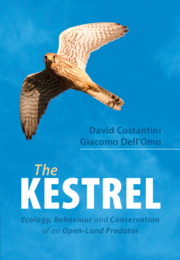Book contents
- The Kestrel
- The Kestrel
- Copyright page
- Contents
- Preface
- 1 Systematics and Evolution of Kestrels
- 2 Feeding Ecology
- 3 Habitat Use
- 4 Breeding Density and Nest Site Selection
- 5 Colourations, Sexual Selection and Mating Behaviour
- 6 The Reproductive Cycle: From Egg Laying to Offspring Care
- 7 Ecological Physiology and Immunology
- 8 Environmental Toxicology
- 9 Movement Ecology
- 10 Conservation Status and Population Dynamics
- References
- Index
- Plate Section (PDF Only)
9 - Movement Ecology
Published online by Cambridge University Press: 29 August 2020
- The Kestrel
- The Kestrel
- Copyright page
- Contents
- Preface
- 1 Systematics and Evolution of Kestrels
- 2 Feeding Ecology
- 3 Habitat Use
- 4 Breeding Density and Nest Site Selection
- 5 Colourations, Sexual Selection and Mating Behaviour
- 6 The Reproductive Cycle: From Egg Laying to Offspring Care
- 7 Ecological Physiology and Immunology
- 8 Environmental Toxicology
- 9 Movement Ecology
- 10 Conservation Status and Population Dynamics
- References
- Index
- Plate Section (PDF Only)
Summary
Common kestrels are defined as partial migrants because they have variable migratory strategies over their geographic distribution, from obligate migrants in the north of Europe to more sedentary habits in central and southern regions. Migratory strategies are subject to a multiplicity of external and internal drivers, which are still not well understood. Many individual kestrels also disperse, rather than migrate, from the breeding or birth area. Dispersal distances are longer in females than in males and in yearlings than in older individuals. The dispersal is influenced by a number of factors, such as individual propensity and food availability. The deployment of GPS data-loggers and geolocators on kestrels will greatly improve our understanding of their movement ecology and help to discriminate between migration and dispersal.
Keywords
- Type
- Chapter
- Information
- The KestrelEcology, Behaviour and Conservation of an Open-Land Predator, pp. 146 - 157Publisher: Cambridge University PressPrint publication year: 2020

